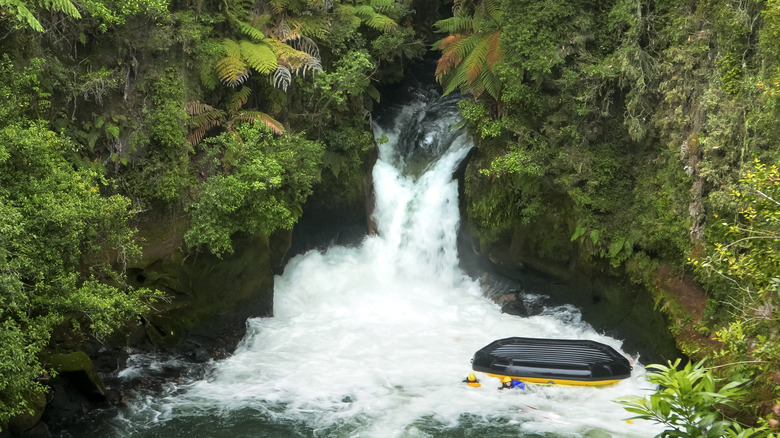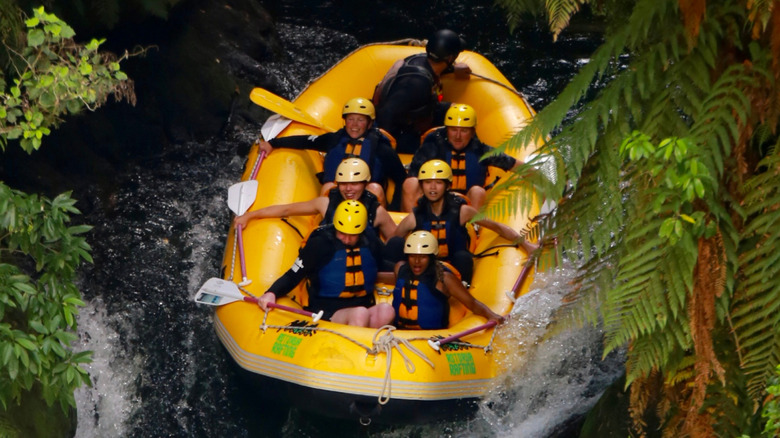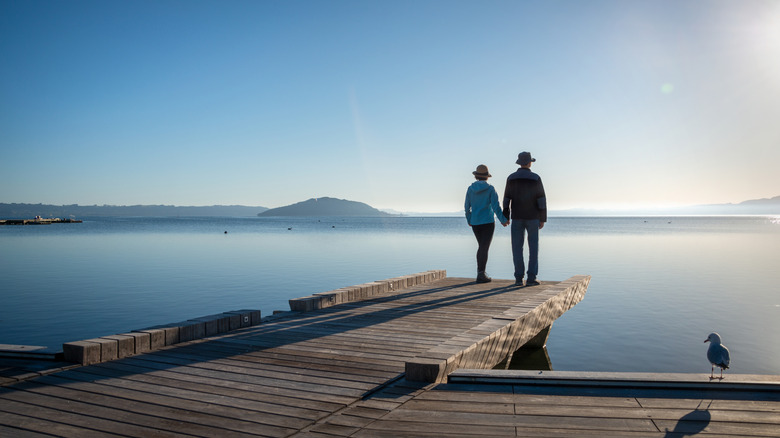
New Zealand isn't short of adrenaline-laced thrills. The remote island nation is a natural playground, from the adventure capital of the world, Queenstown, to its epic fjords and volcanic peaks. But even outdoor fanatics need to push their limits a little. And that's exactly what the jaw-dropping vertical plunge at Tutea Falls, the world's highest commercially rafted waterfall, is for.
Confused about the commercially rafted statistic? That just means it's the tallest waterfall regularly used for rafting.
Of course, other waterfalls are taller, but you couldn't take a raft down this rarely visited, giant waterfall in Yellowstone National Park. Tutea clocks in at a whopping 23 feet, with visitors cascading down the waterfall as part of an extended Grade Five whitewater rafting route through the New Zealand rainforest. Think you could hang on?
The falls form a segment of the Kaituna River, which flows north from the Rotorua and Rotoiti lakes for 27 miles before emptying into the excellently-named Bay of Plenty on New Zealand's North Island. Whether you're visiting purely for the rafting or the experience is a part of a broader itinerary, Tutea Falls is the perfect place for adventurous tourists to check another epic experience off their bucket list. The best part? The falls are just the tip of an adrenaline-tinged iceberg.
Read more: The 5 Best Hidden Hot Spring Hikes In California
What To Expect From Rafting At Tutea Falls

The vertical plunge at Tutea Falls is only a fraction of a second, but you'll be clinging to your raft for almost an hour as it battles down unforgiving rapids. The exact obstacles rafters face will vary depending on the tour company used and the routes taken. The upper section, where Tutea Falls is found, is generally used for commercial trips, and the lower gorges are more demanding. Depending on the tour, you'll navigate through 14 rapids and three waterfalls, all with the leadership of an experienced rafter. Generally, experiences are limited to a maximum of seven guests, but there are smaller raft options and even kayak tours for more experienced visitors.
Know that it's not uncommon for rafts to capsize or people to be thrown during the waterfall drops. Rest easy knowing you'll be fully briefed on safety procedures before you start and decked out in helmets and life vests. There is also a hiking path that follows the river and has a viewing deck near the falls; depending on your own disposition, it may help to watch a few rafters complete the drop first to ease any worries.
But if rafting isn't your thing, don't worry. Rotorua's stunning Hell's Gate Geothermal Reserve and Mud Spa is a relaxing alternative (or add-on). It's delightfully hot baths have been used by the indigenous Māori people for centuries and are said to heal the body. There's another waterfall there, too -- but this one's heated, and you won't get thrown down it. The Rotorua region is also an immensely important place for the Māori, and there are countless ways to dive into the culture. If you don't have a New Zealand trip planned in the near future, check out Big Bend National Park for its Rio Grande rafting and hot springs.
How To Plan A Trip To The World's Highest Waterfall For Rafting

To get to the Kaituna River and Tutea Falls, you'll need to find a way to Rotorua, the nearest town. Rotorua is a delight in itself, brimming with Māori culture and its famous geothermal geysers. There is a small airport with direct links to Auckland, Wellington, and Christchurch, making it fairly simple to get there from one of the country's major hubs. While rates are generally affordable, expect fluctuations during holidays or other peak times in the year.
If you don't want to fly, driving from Auckland will take around three hours. It's an excellent drive and could be done as part of a road trip over 10 days in New Zealand. There are also regular buses from Auckland. These will take a little longer, clocking in at around four hours. There are also plenty of excellent hotels in Rotorua, from expensive lakeside properties to cheaper hostel-style accommodation. Whichever you prefer will dictate the price.
When it comes to booking your tour, you have multiple options. There are several groups running rafting experiences on the Kaituna, as well as other rivers in the area. You can expect to pay anywhere between $80 and $180 at the time of this writing. The more expensive options are often combined packages, offering other rafting or adventure experiences.
Ready to discover more hidden gems and expert travel tips? Subscribe to our free newsletter for access to the world's best-kept travel secrets.
Read the original article on Islands.












